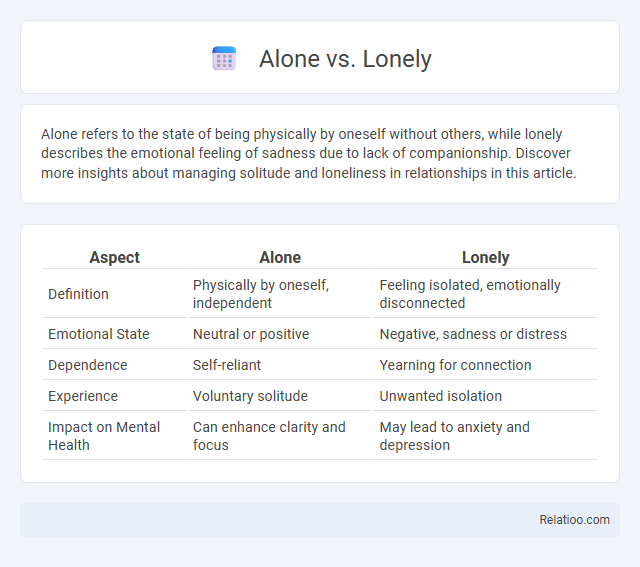Alone refers to the state of being physically by oneself without others, while lonely describes the emotional feeling of sadness due to lack of companionship. Discover more insights about managing solitude and loneliness in relationships in this article.
Table of Comparison
| Aspect | Alone | Lonely |
|---|---|---|
| Definition | Physically by oneself, independent | Feeling isolated, emotionally disconnected |
| Emotional State | Neutral or positive | Negative, sadness or distress |
| Dependence | Self-reliant | Yearning for connection |
| Experience | Voluntary solitude | Unwanted isolation |
| Impact on Mental Health | Can enhance clarity and focus | May lead to anxiety and depression |
Understanding the Difference: Alone vs Lonely
Alone refers to the physical state of being by oneself without others present, while lonely describes the emotional feeling of sadness or isolation that can occur even when surrounded by people. Understanding this distinction helps in recognizing that alone is a neutral condition, whereas loneliness is a subjective experience linked to emotional distress. The concepts highlight the difference between objective solitude and the subjective perception of social disconnection.
The Psychology Behind Being Alone and Feeling Lonely
Being alone is a physical state where you are by yourself, whereas feeling lonely is an emotional experience of isolation regardless of your social situation. The psychology behind this distinction highlights that you can be alone without feeling lonely, as solitude can promote self-reflection and mental clarity. Loneliness often stems from unmet social needs and can negatively impact mental and physical health if persistent.
Signs You Are Alone, Not Lonely
You are alone when physical solitude surrounds you without necessarily feeling emotional distress. Signs you are alone, not lonely, include a content or peaceful state, engaging in hobbies, and maintaining a positive mindset without craving social interaction. Understanding this distinction helps you appreciate solitude as a choice rather than a source of sadness.
Emotional Impact: Loneliness vs Solitude
Loneliness often triggers feelings of sadness, anxiety, and emotional distress due to a perceived lack of social connection, negatively impacting mental health and well-being. Solitude, by contrast, can provide a positive, intentional state of being alone that promotes self-reflection, creativity, and emotional rejuvenation. Understanding the emotional impact of loneliness versus solitude highlights the importance of quality social interactions and the value of choosing solitude for mental clarity.
Benefits of Solitude: Embracing Being Alone
Embracing solitude allows you to recharge mentally and gain clarity, fostering creativity and self-awareness. Being alone differs from loneliness, as it offers intentional isolation that nurtures personal growth without the negative emotional weight of feeling lonely. Benefits of solitude include enhanced focus, reduced stress, and strengthened emotional resilience, making alone time a vital practice for overall well-being.
The Dark Side: Dangers of Chronic Loneliness
Chronic loneliness poses serious risks to your mental and physical health, including increased stress, depression, and weakened immune function. Unlike being alone, which often offers a chance for self-reflection and recharge, loneliness signifies a distressing gap between desired and actual social connections. Understanding the dark side of loneliness highlights the importance of fostering meaningful relationships to protect your well-being and prevent long-term harm.
How Society Perceives Alone vs Lonely
Society often perceives being alone as a voluntary state linked to independence and self-reflection, while loneliness is viewed as an involuntary emotion associated with social isolation and distress. Being alone can carry positive connotations of solitude and personal growth, whereas loneliness is commonly seen as a negative condition requiring social connection or intervention. This distinction influences social attitudes, stigmatizing loneliness while sometimes valuing time spent alone.
Strategies to Transform Loneliness Into Fulfilling Solitude
Transforming loneliness into fulfilling solitude involves cultivating self-awareness and engaging in activities that promote personal growth and mindfulness, such as journaling, meditation, or creative hobbies. Building a supportive social network while embracing alone time helps balance human connection with the benefits of solitude. Practicing gratitude and setting intentional boundaries further enhances emotional resilience, enabling a positive reframe of solitude as an enriching experience rather than a lonely state.
Building Healthy Relationships with Yourself
Feeling alone means physically being by yourself, while lonely reflects an emotional state of sadness due to lack of connection. Loneliness can negatively impact mental health, making it essential to build a healthy relationship with yourself through self-compassion, mindfulness, and self-care. Cultivating your internal dialogue helps transform solitude into a positive experience, empowering your emotional resilience and well-being.
Alone or Lonely: Finding Balance and Well-Being
Alone refers to the physical state of being by oneself, often neutral or positive when chosen, while loneliness describes the emotional feeling of sadness from lack of social connection. Finding balance involves recognizing when solitude supports well-being versus when feelings of loneliness may require social engagement or mental health support. Cultivating meaningful relationships and self-awareness helps transform being alone into a healthy and empowering experience.

Infographic: Alone vs Lonely
 relatioo.com
relatioo.com